
LAB 21 Introduction
Nerves of the Pelvic Limb & Pelvis
and Arteries of the Pes
(Guide to the Dissection of the Dog, 8th ed., pp. 205-217)
CONTENTS:
Lab Objectives:
Medial View
• Find nerves that innervate the pelvic limb:
- obturator nerve (to medial thigh muscles)
- femoral nerve (to cranial thigh muscles) & saphenous n. (medial limb)
Lateral View
• Find nerves from sacral plexus to pelvis:
- pudendal nerve (SE and GSA to/from pelvic organs)
- pelvic nerve (VE and GVA to/from pelvic organs)
- caudal cutaneous femoral nerve
• Find nerves that innervate the pelvic limb:
- lumbosacral trunk (L6, L7, & S1)
-- cranial gluteal n. (gluteal & tensor fasciae latae mm.)
-- caudal gluteal n. (superficial gluteal m.)
- sciatic (ischiatic) n. (L6, L7, S1, & S2 )
-- tibial n. (caudal muscles of crus & plantar pes sensation)
-- common fibular (peroneal) n., divides into: superficial & deep fibular (peroneal) nn.
(cranial muscles of crus & dorsal pes sensation)
• Optionally, dissect lumbosacral plexus (L4 to S3 ventral branches),
located within sublumbar musculature and in the pelvic cavity.
• Arteries of the pes:
- dorsal pedal a. = cranial tibial a. re-named in the pes (foot)
-- arcuate a.
- perforating branch
Anatomical Terms:
Pelvic Limb: nerves
Lumbosacral Plexus:
obturator nerve
femoral nerve
saphenous nerve
pudendal nerve
caudal rectal nerve
perineal nerves
dorsal nerve of the penis (clitoris)
caudal cutaneous femoral nerve (do not ned to identify)
lumbosacral trunk
cranial gluteal nerve
caudal gluteal nerve
sciatic nerve
common fibular (peroneal) nerve
lateral cutaneous sural n.
superficial fibular (peroneal) n.
deep fibular (peroneal) nerve
dorsal digital nn.
tibial n.
caudal cutaneous sural nerve
plantar digital nn.
Pes: arteries
dorsal pedal a.
arcuate a.
dorsal metatarsal aa.
perforating branch
plantar digital aa.
Note:
coxa [Latin = hip] e.g., os coxae = bone of the hip
ischium [Latin & Greek ischion = hip] - caudal part (bone) of hip bone
sciatic [Latin: sciaticus = pertaining to the ischium]
ischiatic [Latin: ischiaticus = pertaining to the ischium]
saphenous [Greek: saphaina = manifest, seen clearly]
peroneal [Latin: peroneus = fibula]
Instructor Commentary:
The lumbosacral plexus which innervates the pelvic limb and pelvis, is formed by ventral branches of spinal nerves L4 to S3 in the carnivore. These ventral branches exchange axons and give rise to individual nerves that contain axons from multiple segments. The lumbar portion of the lumbosacral plexus is located inside sublumbar musculature.
Innervation of the pelvic limb may be summarized as follows: The obturator n. innervates medial (adductor) muscles. The femoral n. innervates cranial muscles of the thigh. All remaining muscles of the limb are innervated by the sciatic n. After sending branches to the hamstring muscles, the sciatic innervates muscles of the crus with two branches: the tibial n. to caudal muscles and the common fibular (peroneal) n. to cranial muscles. Note: The sciatic nerve arises from the lumbosacral trunk, which is formed by L6, L7 & S1. The trunk becomes sciatic n. after it is joined by the S2 ventral branch, which occurs after the trunk gives off the cranial & caudal gluteal nerves.
The sacral portion of the lumbosacral plexus gives rise to two principal nerves (in addition to cutaneous nerves): The pelvic n. carries parasympathetic visceral efferent innervation to pelvic viscera (smooth muscle and glands) and general visceral afferents from the viscera. The pudendal n. carries somatic efferent innervation to anal and urethral voluntary sphincters and general somatic afferent innervation from pelvic structures including the anus and penis/clitoris.
NOTE: The lumbosacral plexus paragraph in Guide to the Dissection of the Dog (p.195) states that the lumbosacral plexus begins with the L1 ventral branch (which is official NAV terminology). However, with one exception, the first three lumbar ventral branches run independently. The actual plexus begins at L4 (L4 through S3). The one exception is that genitofemoral nerve fibers commonly arise from L3 & L4.
Dissection Steps:
Click to view a PDF list of dissection procedures for this lab:
Show List of Dissection Steps (PDF)
Dissection Images:
Note: Click an image to see it enlarged, view its caption, and toggle its labels.
| 1 | 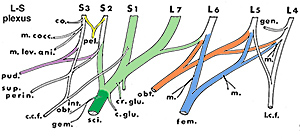 |
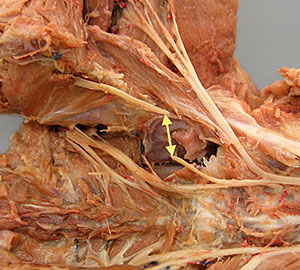 |
2 |
| 3 | 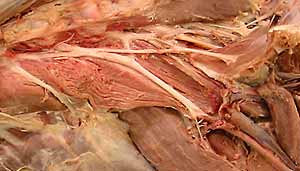 |
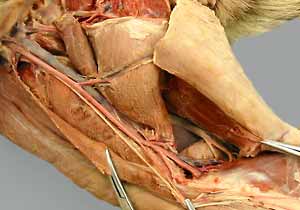 |
4 |
| 5 | 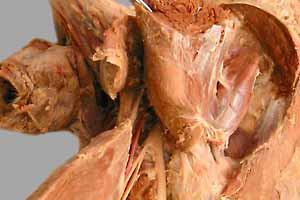 |
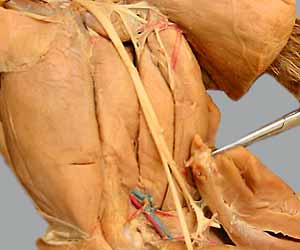 |
6 |
| 7 | 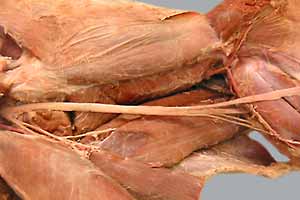 |
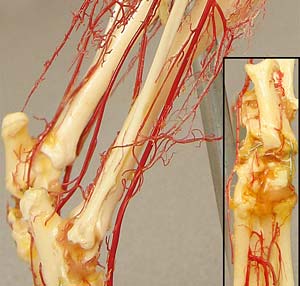 |
8 |